Walk into the past
As India celebrates her 69th Independance Day, Express TravelWorld explores heritage walks as a niche tourism product, showcasing a destination’s rich cultural treasures
Mumbai
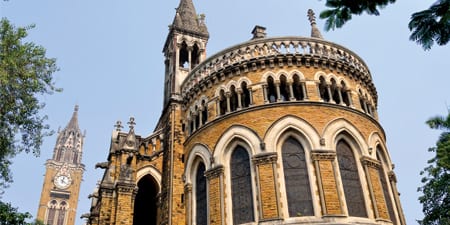
Mumbai’s history offers many heritage structures and historical precincts, which display an eclectic mix of architectural gems, ranging from traditional Islamic to Indo-Gothic styles. Most are located in the south of Mumbai, as historically, access to the city was only through the port there. The southern tip of the city is home to the Fort precinct, the urban core of Bombay, which during the colonial period was enclosed by fortified walls. Mumbai had 591 heritage structures registered as of 2012, which includes buildings, archaeological sites, colonial, industrial, domestic architectural sites and public spaces. Most of the structures were built during the British period. They are in the Victorian Neo Gothic architectural style, Indo-Saracenic Revival or Neoclassical styles. The Elephanta Caves and Chhatrapati Shivaji Terminus railway station are recognised as World Heritage Sites. Mumbai is also home to a large number of Art Deco structures, with the largest count of buildings in this style after Miami. Many of these buildings are cinema halls, such as Eros Cinema and Regal Cinema. A string of Art Deco apartment buildings line the city’s waterfront promenade, Marine Drive.
Walking tours expose many residents and visitors to these structures. They are sponsored by the Bombay Heritage Walks group, established in April 1999. The heritage walks aim to raise the awareness of the people of Mumbai and visitors, about the city’s architecture and heritage monuments. Personalised, educative and imaginative, the walking tours highlight the vast range of architectural styles, planning elements and ornamental details, tracing the social and cultural history of the city. The heritage walks are offered in English or French and in two time slots – 9:00 am and 4:30 pm.
On the Kala Ghoda Route, you will see a veritable parade of archetypal Neo-Gothic public buildings built in the 1860s and 70s such as the glorious Bombay University Library with its high campanile and the grand imposing High Court that are south Mumbai’s main architectural attractions. Fronting this line of historic Gothic edifices across the open space of Oval Maidan is a row of 1930s Art Deco apartment buildings making this a marvellously unique setting both visually and architecturally. Other highlights on this heritage route are the culturally vibrant Kala Ghoda node with recently restored Elphinstone College, the ‘miniature Gothic’ David Sassoon Library, the Neo-Classic Army and Navy building and much more.
The city’s long association with the British is reflected in the old world charm of its buildings made in varying styles – from the early 1800s Neo Classic to the late 1860s Victorian Neo Gothic, to the early 20th century Indo Saracenic style of architecture that combined Gothic-like flamboyance with Muslim-Indian architectural features to the flamboyant Art Deco of the 1930s and 40s. On the Horniman Circle Route you see some of the city’s well-known landmarks, in the heart of the old Fort area – Mumbai’s oldest business district. Besides their heritage value, the presence of over 30 banking establishments and important financial institutions renders the area into Mumbai’s principal tourist and commercial hub. The tour starts at the Asiatic Library where you are given an introduction to Mumbai, its historical background, geographic morphology and are told about the surrounding Fort precinct including the Asiatic Library, Horniman Circle, etc.
The stepped tank called Banganga, surrounded by temples (mandirs), memorials (samadhis), hermitages (mutts), pilgrim rest houses (dharmasalas) and residences, stands on the western fringes of Malabar Hill in south Mumbai. Over the decades, and particularly since the intensive development of Malabar Hill beginning from the 1960s, this tranquil, historic centre of pilgrimage has been severely transformed by being virtually engulfed by haphazard highrise development in the environs.
The Banganga Walking Tour takes you for a ‘parikrama’ or holy circumambulation around the Banganga tank, stopping at various temples along the way. History and legends associated with this incredible locality are unfolded on the tour. You will see that even though the physical state of the complex has deteriorated considerably, the ambience and sanctity of Banganga is still intact.
Delhi
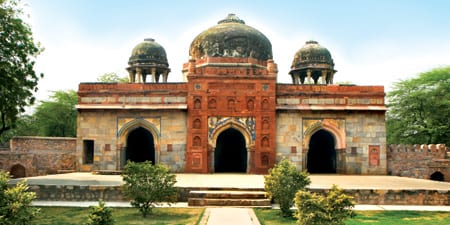
Delhi offers an interaction between ancient, medieval and modern. Its monuments are the most evident traces of its past, spanning a period of almost a 1000 years. They highlight Delhi’s historic role as a capital city. Different dynasties built their capitals here. Some altered and extended existing ones, others built new cities. One can count anywhere between eight to 15 sites where a new city was built: Anangpur and Lal Kot in the early medieval period; Tughlaqabad and Kotla by the Sultanate rulers; the Mughal capital of Shahjahanabad and most recently, New Delhi, built by the British.
To make the citizens aware of the importance of this cultural and historical environment, organisations like INTACH Delhi Chapter have been regularly conducting heritage walks in various areas of Delhi. For instance, a walk through Chandni Chowk, the main street of the old city of Delhi (Shahjahanabad), is a fascinating experience.
Delhi Heritage Walks conducts walks in various parts of the city. The walk around Chandni Chowk covers Shri Digambar Jain Lal Mandir, Gauri Shankar temple, State Bank of India, Central Baptist Church, Sisganj Gurudwara, Sunheri Masjid, Paranthewali Gali, Naughara, Dharampura, and Gali Guliyan. The walk ends at the gate of the Jama Masjid.
The company’s Hauz Khas heritage walk explores the medieval ruins of this village and the Deer Park. The highlight of this area is the 13th century reservoir which has now been revived and the renowned madarsa. Beside the madarsa is also the tomb of its royal founder, Firoz Shah Tughlaq. The Deer Park has some buildings with names like ‘the dome in the garden of the world’ and ‘the gifted dome’. Several other pavilions, tombs and mosques are to be found in the surrounding park.
The Delhi Heritage Walks also covers Lodi Garden, which has the royal tombs of medieval rulers of Delhi – Muhammad Shah Sayyid and Sikander Lodi; a gateway called Bara Gumbad with an exquisitely decorated mosque, Shish Gumbad; a 16th century bridge and a couple of Mughal monuments.
The walk around the Kashmiri Gate and its neighbourhood takes you through the landmarks of the uprising of 1857. It also covers life and times of the British living in the city before the revolt broke out. The trail includes Nicholson Cemetery, Kashmiri Gate, St James Church, old campuses of Hindu College and St Stephen’s College, Dara Shukoh’s library, Telegraph Memorial and remains of the British magazine.
One of the largest mosques in Asia, the Jama Masjid offers a view of the entire old city. This walk takes you through the narrow lanes of Old Delhi with mansions, colourful bazaars, Jain temples and stalls selling street food. The walk through this complex takes you through a royal tomb which once stood in a lake, palace buildings, dungeons and a secret escape route.
The walk of the Mehrauli Village explores the area behind the famous Qutb complex. A historic village, Mehrauli is built around the Sufi shrine of Bakhtiyar Kaki. Each monument in the neighbourhood has a story to tell – stepwells where water smelled of sulphur, a tank where Prophet Muhammad left a mark, martyrdom site of Sikh hero Banda Bahadur, a palace of the Mughals and an empty grave for the last Mughal emperor.
Kolkata
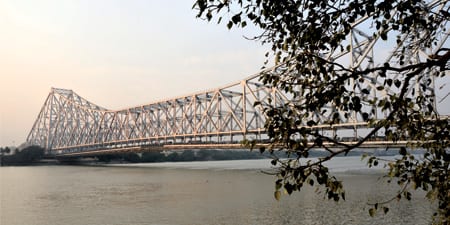
Until December 1911, Kolkata (then known as Calcutta) was given a lot of importance by the British empire. The British East India Company had the state as its hub for trading, political and administrative business. Holding an interesting line of stories, Kolkata has an immensely rich cultural heritage and a lot to offer to tourists from the Dalhousie Street to the Victoria Memorial, Hazarduari, Shaheed Minar and the Terracotta Temple in Murshidabad.
To pay homage to its heritage, travellers can opt for specialised walks to familiarise themselves with the various architectural styles of 18-19th century Kolkata. The route begins from The Shaheed Minar (formerly known as the Ochterlony Monument) on Dufferin Road, Maidan to Town Hall and High Court, further ahead to Hare Street towards Metcalfe Hall down towards Koilaghat Street to Bankshall Court, Eastern Railway offices, Netaji Subhas Chandra Road to corporate buildings of early 20th century.
For a glimpse of Bengali Renaissance, specialised tours begin from Old Bengali residences towards Jorasanko Thakurbari (Tagore House) to Pathuriaghata street and then towards PK Tagore street and Sovabazar street. The route to explore Waterfront Walk begins from Fort William on the eastern banks of the River Hooghly to Princep Ghat- Babu Ghat – Chandpal Ghat, then towards the Old Strand warehouses proceeding towards Mullick Ghat to the flower market and then end the tour at Nimtollah Ghat.
Known to be a busy trading hub in the 18th century, the market had varied products such as spices, muslin, opium, indigo and jute. The Armenians had set up business since the early 1700s. The Jews and Parsis followed. The Chinese were not left behind either and the earliest record of a Chinese doing business in Kolkata dates back to 1780. They brought with them skills of cabinet making, carpentry and shoe making. To soak into the cultural mosaic of these communities, the route that travellers can opt for starts from The Armenian Church in the northwest corner of Barabazar and head towards Canning Street towards M.David Synagogue and then ahead to the Portuguese church, further down to Saifi Mosque and Bethel Synagogue. After these, one can proceed towards Lalbazar to the Chinese Church and Mission Row – Old Mission Church.
For a British Raj reverie, tours begin from meandering through the area near and around the Dalhousie Square, now known as the BBD Bagh area near the Hooghly river in the western part of central Kolkata and is a square built around the old Lal Dighi tank. The old fort built by the British was where the general post office is now. The area was in the heart of Kalikata or the White Town in old Kolkata. This walk takes travellers down the 18th and 19th century history highlighting the architecture of Kolkata, and it is the present administrative hub, which has been important during the British, named after Lord Dalhousie, who was the governor general in the 1850s.
The route begins from Raj Bhavan at BBD Bagh to Treasury Building to St John’s Church to GPO Philatelic Museum. Further moving towards Collectorate Building on to the Writer’s Building, to St Andrew’s Church and then a stopover at the Old Currency Building, one can then head towards the Central Telegraph building to outhouses of Raj Bhavan, ending the tour at the Great Eastern Hotel (now known as The Lalit Great Eastern Kolkata).
Lucknow
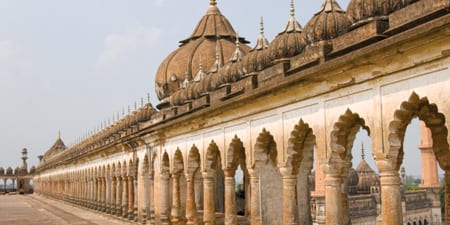
The city of Lucknow with its rich repository of historic monuments is a perfect destination for heritage walks – reflecting the splendour of the Nawabi legacy and the quintessential remnants of the Victorian era. The two hour Lucknow Heritage Walk covers many monuments of historic significance and tourist interest, while at the same time giving an insight into its living cultural legacy – going beyond the monuments into the heart and soul of the city. The walk will take you to the areas where you can see the arts and crafts being practiced through generations – from elaborate zardozi to fine chikan embroidery to production of scented oil ‘itra’ and of course the many iconic food haunts where visitors can try the famous local delicacies.
Lucknow Heritage Walk starts from Lal Pul, and covers Tila Wali Masjid, Bara Imambara, Gol Darwaza, Chowk Bazaar, Phool Wali Gali, and culminates at Akbari Darwaza. An experienced guide accompanies the visitors who answers all questions related to the sites and traditions of Lucknow. The Lal Pul, which is also called the Pukka Pul, across river Gomti is the perfect place to start the heritage walk. This bridge adjoins the Tila Wali Masjid. Also called the Alamgiri Mosque, Tila Wali Masjid is to the north of the Imambara complex. It is believed that Lord Ram gifted the area of Lucknow to his brother Lakshman (from whom the name Lucknow is derived). The ancient Lucknow is connected to the mound called Lakshman Tila, on which the Tila Wali Masjid now stands. It is a beautiful white edifice known for its perfect symmetry.
Next comes Gulab Vatika, a rose garden near Rumi Darwaza, which as the name suggests has wide varieties of roses in bloom. The Rumi Darwaza is the imposing gateway that is considered an iconic symbol of Lucknow. Built by Nawab Asaf-ud-Dowlah in 1784, it is one of the perfect examples of Awadhi architecture. The gate, that is at a height of 60 feet, has been inspired by a similar gateway in ancient Constantinople. Nearby is Naubat Khana or drum house / orchestra pit where the drummers stood during ceremonies.
The walk then takes visitors across to the city’s grandest edifice – the Bara Imambara. The monument has an interesting history and continues to intrigue visitors with its many unique architectural features. Built by Nawab Asaf-ud-Dowlah, it is also called the Asafi Imambara. It is probably the only monument in the world where the architect (Kifayatullah) has been buried alongside the ruler – making it obvious the importance given to man who created the edifice. The nawab was known for his astounding generosity – the story goes that to enable common people to earn money during a devastating famine he asked them to work at the site during the day – at night the (unskilled) noblemen would demolish what was built. The nawab did this so that the people would continue working and earn a living. The famine lasted a decade.
The main hall in the Bara Imambara has no beams supporting the ceiling and is one of the largest such arched constructions in the world. The most interesting aspect for visitors is the maze called Bhulbhulaiya, which is a labyrinth of 489 identical doorways, where you can easily get lost without a guide. The guide will also show you blocked entrances to miles long secret passageways, even going reportedly as far as Faizabad and Delhi. A part of the complex is the grand Asafi mosque. There is also a bowli (stepwell).
At the Chowk Gol Darwaza market visitors can buy chikan clothes at wholesale rates. They can also pickup beautiful pieces of meenakari or kundan jewellery. A stop at the ‘itr’ shop is part of the itinerary.
No visit to Lucknow can be complete without tasting its many famous delicacies – the walk takes visitors to the centuries old Tunday Kebab shop. The iconic Rahim Ke Kulche Nihari is also at Akbari Gate lane.
Lucknow Heritage Walks are conducted by UP Tourism and Tornos Destinations. The latter also conducts Victorian Walk and Culinary (Tour) Walk.
Goa
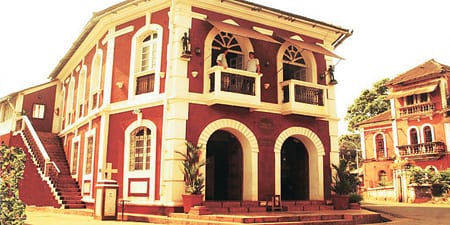
With the rule of the Portuguese for over 450 years and the consequential influence of Portuguese culture, Goa presents a somewhat different picture to visitors than other parts of the country. Goa is one of the few places on the subcontinent where houses dating back to the 1700s are still in well kept condition and is still inhabited by generations of the original owners. Unlike the other colonial powers in India, the Portuguese managed to leave a much more visible mark on the residential architecture of the area they ruled. These palatial houses inspired by European architectural style are still found in Goa, although they are confined to the rural areas such as Chandor and Loutolim. An exception is the commercial town of Margao, which still has some houses in its Borda area. The British and the French left their mark on the architecture of huge buildings such as assemblies and railway stations which have become landmarks of the period.
The best way to explore these heritage sites in Goa is through heritage walks, some of which are conducted by the Goa Heritage Action Group, an NGO in existence since September 2000. Amongst the activities conducted by the Goa Heritage Action Group are four Goa heritage festivals and four Fontainhas Festivals of the Arts. The Fontainhas Festival of the Arts is held in the heritage locality of Fontainhas to raise awareness about its uniqueness and all these festivals are open to the public.
The heritage walk is through the old precinct of Panjim that covers the wards of Sao Tome, San Sebastain and Mala. Panjim became the capital of Goa in 1843 and the oldest residential settlements lived in these three wards. Together these three wards comprise of the precinct of Fontainhas. Settlements in Fontainhas date back to about 150 years and it is the most charming part of the town with its narrow bye-lanes, winding alleys and quaint Indo-Portuguese architecture. Sao Tome is the first ward and its name originates from the chapel of St Thomas at its entrance while San Sebastian is the second ward with the chapel of San Sebatian dominating the area. Both these areas have a large proportion of catholic people while Mala is the ward where a large portion of Hindus reside.
Old Goa, an UNESCO World Heritage Site, comprises mainly of churches and cathedrals like the Se Cathedral, Church of St Francis of Assisi, Church of St Caetano, Chapel of St Catherine and the Basilica of Bom Jesus where the relics of St Francis Xavier are kept.
The walk starts from Panjim Church, and after a point it leads you to the High Court which was formerly the ‘Lyceum’. The Lyceum was a Portuguese high secondary school. The other prominent places to look forward to are – one of the oldest bakeries in Goa, the ’31st January Bakery’, boutique hotels like Casa Fontainhas, Panjim Inn, Panjim Pousada and the St Sebastian Chapel. Surrounding the St Sebastian Chapel Square, you will find old heritage houses, some with beautiful courtyards, the Afonso guest house and a little lane which leads to Viva Panjim, a popular restaurant dishing out some of the best Goan and Portuguese home cooked food.
There is also a Portuguese organisation known as Fundacao Oriente, that has worked a lot for the restoration of the heritage buildings, like the custom house, police headquarters and chapel in Monte in Old Goa. Next to Panjim Inn you will find the Velha Goa Galeria, where you can get anything which is Goan or Portuguese – from Mario Miranda’s cartoons on tiles, to ordering your nameplate on blue and white ornamental tiles, crockery and glassware from Portugal, ceramic showpieces depicting heritage homes and table mats with Mario Miranda’s cartoons.
Shimla
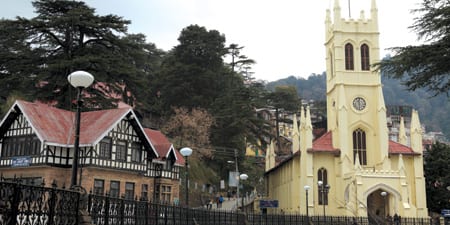
Perceived and established by the British during colonial period in the first half of the 19th century as their summer capital, Shimla acquired global fame by the time they left in 1947. Shimla can be called as ‘a wonder of colonial era’. The British established many architectural masterpieces such as Viceregal Lodge, Gorton Castle, Railway Board Building, Gaiety Theatre, Town Hall, Auckland House, Ellerglie, Barnes Court and Challet Day School. Shimla also has a building called North Bank where Nobel Laureate writer Rudyard Kipling lived in 1907. The 96.5 km section of Kalka-Shimla railway line with 103 tunnels is an engineering feat and provides unique experience to those who travel by this historic route. It is the most spectacular narrow gauge railway line in the world. The city possesses distinct British heritage including institutional buildings, bungalows, churches, socio-cultural spaces, hotels, cemeteries, coffee houses, clubs, theatres, schools, hospitals, street pattern and street furniture, which immensely add to the grace of the city with their distinct expressions.
With a vast history and architecture to marvel at, travellers can begin their heritage walk from Gaiety Theatre, which was erected in 1887, and was the tallest five storey building of that period. The architect Henry Irwin, who designed the Viceregal Lodge, also designed the theatre building. It was a source of entertainment for the Anglo Indian Society. It was first of its kind in Asia. In 1911, as the structure was found to be unsafe, the upper portion of the building was dismantled. Built in stone, with artistically shaped windows, doors, lintels, and openings, it also possessed boxes, galleries, beautiful paintings and sculptures. It was used as a stage for Shimla Amateur Dramatic Club, an important cultural venue. Moving along the way, travellers can stop by at the Scandal Point, known to be the place where Prince of Patiala took up a challenge with the daughter of the Viceroy of India. The prince was thrown out of Shimla and he then made another town (with palace) at Chail near Shimla. Next to Scandal Point there is the General Post Office, and moving ahead is the Catholic Church on the Ridge, built in the Neo-Gothic style in 1857 to serve the British community. The Christ Church is situated on The Ridge where it stands out as one of the prominent landmarks of Shimla. The Municipal Corporation building of Shimla adds to the surrounding architecture, reminiscent of the pre-independence era. The building is preserved in its original form. For a religious tryst, one can visit the Kali Bari Temple, which was built in 1845 and is believed to be the ancient temple of Shamla, i.e. the goddess Kali. The last stop for the tour can be at the Railway Board Building, which was built in 1896-97. This unusual cast iron and steel structure once held the offices of the Railway Board and the Department of Commerce. But at a time when safety was a core-consideration for important buildings throughout the British Empire, this was designed to be structurally fire-resistant, and a recent blaze in Shimla has been testimony to this. The building was originally designated as the ‘Public Works Department Secretariat Offices’ and was fabricated by the Bombay based firm of Rishardson and Cruddas.
After the half day visit, the walk can proceed towards the Observatory Hills where the Viceregal Lodge is located. It was known as Rashtrapati Niwas, and was formerly the residence of the British Viceroy Lord Dufferin, which was the venue for many important decisions, which changed the fate of the sub-continent. After independence, the lodge remained the summer retreat of the President of India. In the early 60s the President of India, Dr S Radhakrishnan, a leading philosopher and writer, and then Prime Minister Jawaharlal Nehru decided to make it a scholars’ den where the best minds would find an ideal retreat. That’s when the Indian Institute of Advanced Study moved into the lodge in 1965.
Shimla is also home to the Vidhan Sabha. The edifice was completed and inaugurated by Lord Reading, the then Viceroy of India, on August 27, 1925. The need for this building arose as the British chose Shimla as the summer capital of the Imperial Government. The Gorton Castle is one of the most striking buildings of the British empire, and is a Neo Gothic structure that had the famous Sir Swinton Jacob as its architect.
Ahmedabad
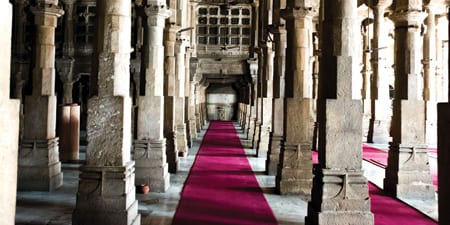
Ahmedabad was found in 1411 on the ancient site of Ashaval and Karnavati. The city has some of the finest Indian and Islamic monuments and exquisite Hindu and Jain temples. Its carved wooden houses are another unique architectural highlight. The Heritage Walk of Ahmedabad is conducted by the Ahmedabad Municipal Corporation (AMC). Since November 19, 1997 as a part of the World Heritage Week, AMC has been conducting The Heritage Walk of Ahmedabad for its project ‘Getting the City to the
People’.
The Heritage Walk of Ahmedabad is a guided walk of two and a half hours. This daily affair by the AMC is designed in guidance and co-operation with CRUTA and Swaminarayan Trust, being operated by a group of young volunteers. There is also a half hour special slide show unfolding the city’s history from the time of its birth in the 10th century AD to the present walled city re-founded during the period of Ahmedshah and onwards.
A special feature of Ahmedabad is the plan of the old city, comprising numerous ‘pols’, which are self-contained neighbourhoods, sheltering large number of people. Some of these pols are virtually small villages, traversed by narrow lanes, usually terminating in squares (chowks) and comprising the community well and chabutro (for feeding birds). These pols were protected by gates, cul-de-sacs and secret passages. These historic residential settlements are explained in detail during the walk.
The walk begins from the picturesque Swaminarayan Mandir in Kalupur and ends in the fascinating architectural legacy, the Jama Masjid, covering in between the numerous pols, havelis, ornamental facades, workplaces of artisans and number of magnificent Hindu and Jain temples. The walk proceeds from Kavi Dalpatram Chowk – which housed the great 19th century Gujarati poet in Lambeshwar ni Pol, to the city’s textile era – the Calico Dome and the century old Kala Ramji Mandir in the Haja Patel ni Pol which has a unique idol of Lord Rama in a dark colour and in a sitting posture.
During the walk through Doshiwada ni Pol, Zaveri Vad to Chaumukhji ni Pol, you can witness ornate temples with their beautiful wooden carvings hidden under plain exteriors and camouflaged beneath the aura of the Mughal rule, lanes punctuated with intriguing chabutras, and a three foot wide alley leading into the 110-year old Harkunvar Shethani ni Haveli.
Moving through the historical Fernandez Bridge to Manek Chowk where amidst the deafening traffic and full of parked vehicles the guide will explain to you about the legend of Manek Baba after whom the chowk was named and Manek Baba Mandir, at the site where he shrank and entered a bottle to show his magical powers to Ahmed Shah, the founder of the city. Finally one can visit the Rani no Hajiro and Badshah no Hajiro to end the walk at the Jama Masjid.
Another heritage walk tour organiser, The House of MG has its own unique tour called the ‘D-Tours’, an audio synchronised heritage walk, complete with instructions and interviews with common people. It includes market sounds, vendor calls, people chatter, temple bells, mosque chants, bird twitter and other road sounds.
Starting from The House of MG to the Sidi Saiyed Mosque, to the Bhadra Fort, the busy Gandhi Road, the Teen Darwaza Gate and the Jama Masjid mosque. The tour ends at a stunning wooden haveli in Lakha Patel ni Pol.
Mysore
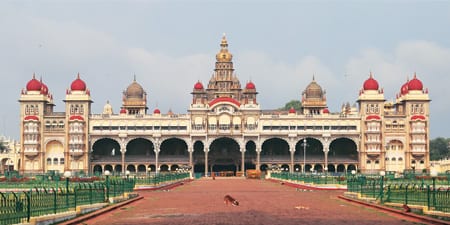
The city of Mysore, located 139 km from Bengaluru, is famously known as the ‘Sandalwood City’. Mysore is a quiet and placid town unlike the industrial and cosmopolitan capital city – Bengaluru. The aura of grandeur and royalty is still present in Mysore, the official capital of the erstwhile Maharajas. Buildings with vaulting archways and majestic domes are a common sight in Mysore.
Royal Mysore Walks is a local tour operator which organises heritage tours called the ‘The Royal Walk’ which takes travellers through the royal connections and colonial link to Mysore. On this tour, one can get to connect different world events like the American War of Independence, French Revolution and the Battle of Waterloo to Mysore. Also travellers can get to taste the famous Mysore Pak sweet from the family who invented it. The tour also takes one through the 125 year old market known for its colours and vibrancy.
The starting point of the walk begins from the historic Town Hall building which has been the epicentre of the city planning activities during the royal era. This building was inaugurated on April 1, 1884. Next the tour takes you to one of the most interesting and unexplored heritage site called the Secret Society. The Secret Society which was mentioned in the Da Vinci Code book has its presence in Mysore. The building structure is much older than the Mysore Palace and interestingly the society is still active.
The tour then takes you to the Clock Tower which is situated in the heart of Mysore with major arterial road meeting at this point. This beautiful heritage tower was built in 1927 to commemorate the 25 year rule of the Mysore king Nalwadi Krishnaraja Wodeyar. This Clock Tower is situated close to the Town Hall and is opposite to Chamarajendra Circle near the Balarama Gate of Mysore Palace. This tower was built in Indo-Saracenic style. The dial of the clock is etched with numbers in Kannada. The tower is also known as Dodda Gadiara, which means the ‘big clock tower’ in Kannada. Interestingly, there is also a small clock tower called Dufferin Clock Tower located near K R Circle. From the Clock Tower travellers can visit the statue square.
Next heritage property is the Jaganmohan Palace. This palace is divided into two parts- the main building lying to the west and a spacious pavilion to the east. The pavilion was used for marriages and other purposes when the old palace was burnt. The western, older building is a treasury of pictures and models, illustrating Mysore’s history and personalities. The ground floor contains a number of paintings giving the genealogy of the Mysore kings and other articles of great interest. The second floor adorns the paintings of great painters from different countries of the world. One of the most attractive paintings is of the ‘Lady with the lamp’. In one of the rooms there are items used by the great warrior Kantivrava Narasaraja Wodeyar. On the third floor, the Rung Mahal or picture hall, has many quaint and interesting mural paintings. There is a room that contains pictures of the modern school, Kolkata and some examples of the work of Mysorean, K Venkatappa. One big hall is dedicated to the paintings of Raja Ravi Varma. Finally, the walk ends at Devaraja market, which is one of the best places to get a flavour of the local people’s daily life. With more than 100 years of history, this market is well knitted into the heritage of Mysore. The northern side of the market is usually filled with stalls selling fruits, mostly banana. The southern part is for selling vegetables. And there is a section in the middle where one can find rows of shops selling the local flowers. This market was the inspiration for RK Laxman’s cartoon character – The Common Man.
Amritsar
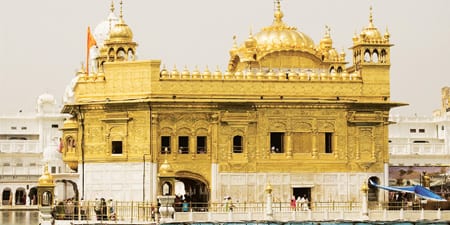
Amritsar was founded by Sri Guru Ramdass, the fourth guru of the Sikhs in about 1574 AD. Before the city was founded, the area was covered with thick forests and had several lakes. To start the city the guru invited 52 traders from different sects belonging to nearby places like Patti and Kasur to settle here. These families started the first 32 shops in the city which still stand in the street called Batisi Hatta (32 shops). The guru himself shifted to live among them in the city which came to be called Ramdaspur and has been eulogised in the Guru Granth Sahib. The construction of Amrit Sarovar from which the city gets its present name was also started by Guru Ramdass. His successor, Guru Arjan Dev, completed the project and located the Harmandir Sahib in its midst.
The heritage walk is a guided tour deep inside the narrow lanes and by-lanes of the 400 year old city of Amritsar. One gets to see Katras, Akharas, Bungas, Havelis and Hattis – the vocabulary of traditional town planning and architecture. The walk takes you back in time as you witness traditional trades and crafts being practised in the same place and in the same manner, as it has been done for centuries. In the old town is the famous Golden Temple, which is the holiest shrine of the Sikh faith and displays a harmonious blend of Mughal and Rajput architecture. The temple sits at the centre of the Amrit Sarovar, or the ‘pool of the nectar of immortality’. The present temple complex dates from 1776-84 – the gold ornamentation of the Harmandir Sahib was donated by the legendary Maharaja Ranjit Singh. The walk begins from The Town Hall, built by the British in 1866, which is the centre of Amritsar’s local administration. Near the police station there is a Jaan Mohammad Mosque. This mosque was built by Mian Jaan Mohammad in the Hijri Year 1289 (1872 AD). Just near this heritage building there is another building housing Punjab National Bank. Long before the partition it was named Lal Haveli and it housed an oil and a perfume manufacturing factory owned by Kahan Singh and Mohan Singh. Next on the route is the Gurdwara Saragarhi, which is dedicated to the 21 soldiers of the 36 Sikhs Battalion who lost their lives bravely defending their posts on September 12, 1897. The third stop on the route is Qila Ahluwalia, the fort that once belonged to Ahluwalia Misl. Its famous leader Jassa Singh Ahluwalia played a crucial role in repelling foreign invasions during the 18th century. Located in the heart of Amritsar’s commerce sector, Jalebiwala Chowk is a gastronome’s delight. It is home to a world famous jalebi shop that has been in operation since 1956 and is renowned for creating one of the best melt-in-your-mouth treats, sure to satisfy everyone’s taste buds.
The fifth stop on the route is the Udasin Ashram Akhara Sangalwala, founded in 1771 and originally known as Nirvan Akhara after its founder, Nirvan Priyatam Dass. Akhara is sarais for sadhus, yogis and holy men, who stay and practice religious ceremonies. This was originally in a desolate and uninhabited expanse; there was nothing in the area except a large tree where Nirvan Priyatam Dass conducted daily meditation and prayers. Nearly 100 years later, the new Mahant (chief priest) of the Akhara attached a thick iron chain to its main gate, a symbolic act to perpetuate the memory of its creator.
Standing testimony to architectural beauty, the Chitta Akhara, also known as Ganga Ram Akhara after its founder Mahant Ganga Ram, was established in 1781, making it over two centuries old. The Darshani Deori, marks the spot from where Guru Arjun and Guru Hargobind would stand to view the Golden Temple. As there were no buildings around it at that time, there was a clear view of the shrine from this spot. Much later the beautiful painted and gilded ceiling was added.
In the middle of the road near the end of the Bartan Bazaar, there is a large Banyan (Bohar) tree. The Banyan Tree is considered sacred because of its ties to ancient worship and its many inherent beneficial properties.
Entering the courtyard of the Thakurdwara is like stepping back in time, shedding light on the colonial-style architecture that has influenced much of downtown Amritsar. Completed in 1876, the Thakurdwara is dedicated to Lord Krishna and contains two shrines.
Kochi
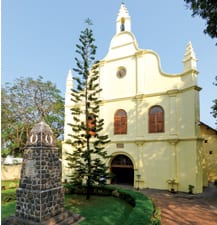 Kochi is one of the few cities in the world that has seen mixed influences of different colonial powers – Dutch, Portuguese, British as well as a touch of Jewish culture. Asia’s oldest Jewish Synagogue as well as the Dutch Palace (Mattenchery Palace) can be found here. The area, which is home to several migrating communities, has evolved its own cultural mix, and you can find temples, mosques, art galleries and cosy cafes co-existing in this quaint landscape. The Bazaar Road that connects to the adjacent area of the former British Cochin to the trade centre makes for a perfect heritage walk, lined by warehouses, many of which are more than 300 years old.
Kochi is one of the few cities in the world that has seen mixed influences of different colonial powers – Dutch, Portuguese, British as well as a touch of Jewish culture. Asia’s oldest Jewish Synagogue as well as the Dutch Palace (Mattenchery Palace) can be found here. The area, which is home to several migrating communities, has evolved its own cultural mix, and you can find temples, mosques, art galleries and cosy cafes co-existing in this quaint landscape. The Bazaar Road that connects to the adjacent area of the former British Cochin to the trade centre makes for a perfect heritage walk, lined by warehouses, many of which are more than 300 years old.
Cochin Magic organises a heritage walk through Fort Kochi, a heritage town which is a cultural melting pot. The walking tour takes you to the old quarter of Fort Kochi with its quaint streets as well as seaside promenade. The meeting point for the two hour walk is the entrance to the 400 year old St Francis Church (India’s oldest European church) built by the Portuguese Franciscan Friars. The walk then covers the Chinese fishing nets that is a trademark of Kochi, the colonial houses that ring the Nehru Children’s Park (Koder House, Tower House, Old Harbour Hotel), Fort Immanuel (a Portuguese bastion), the Dutch cemetery, which is now managed by the Church of South India, and the Santa Cruz Basilica that changed hands from the Portuguese to the Dutch to the English. The walk ends with tea/coffee at a local café. There is also wheelchair assistance for those differently abled.
According to historians, a devastating flood in 1341 wiped out the legendary port of Muziris, the hub of spice trade on the Malabar Coast, and opened up a beautiful natural harbour just south of Muziris. Till then a tiny fishing hamlet, Kochi (earlier known as Cochin) quickly rose to become an important trading hub. In the early 16th century, the King of Cochin, who felt threatened by his neighbour, the Zamorin of Calicut, allowed the Portuguese to build a fort in Kochi.
Another heritage walk, Fort Cochin Heritage Walk will take you around the old Fort on a three-km walk and explain to you the story of the fort over the centuries under the three European powers. The walk covers 31 historical and heritage locations in the town. The tour starts from Burgher Street, and goes around the Bastion Street to the historical Santa Cruz Basilica, before turning to Santa Cruz High School Road. The walk also takes visitors to the Dutch Governor, Henrik Van Rheed’s residence and the prestigious Cochin Club. The walk winds up at the St Francis Church before passing through the Bastion Bungalow, the Chinese fishing nets and the natural harbour.
The net connection
The trademark Chinese nets that dot the Kochi skyline are ancient fishing contraptions that date back to the years of foreign trade with the Malabar Coast. There are differing opinions about the origin of the nets. While some credit the Chinese for its origins (hence the name), others say it was the Portuguese who brought them here either through their trade with China or the know-how from th eir colony in the Far East. Whatever their origins, some of the nets are more than 80 years old, having been recast several times over the years. Made of teak, and operated with stone weights, they are lowered in the waters till they entrap fish and are then hauled up.
Conservationists are making a concerted effort to bring these fishing nets under a heritage label.


